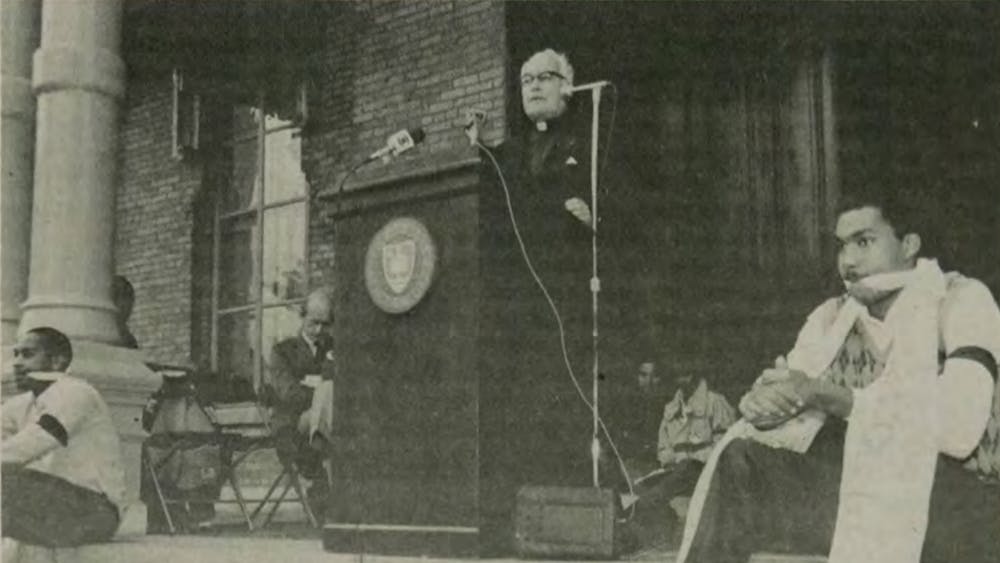
When the first issue of The Observer was released in 1966, the Scene department didn’t exist.
It’s not that our journalistic predecessors hated art — quite the opposite, actually. Early editions of The Observer included detailed analyses of literature, theatre and art exhibitions. These articles just lacked a formal category.
However, The Observer’s earliest scribes of culture also operated alongside the evolution of film as an art form. Thus, their articles deviate from those of present-day Scene writers in a way other than simple categorization.
Today, movies loom large and earn widespread appreciation amongst their audiences. The Observer’s past reporting provides valuable insight into film’s journey from budding medium to cultural powerhouse.
Cinema series aims to demonstrate the versatility of film
Sept. 4, 1974 | Ellen Syburg
Prior to the construction of the Browning Cinema, the Notre Dame film-watching experience looked radically different. An article published in The Observer on Sept. 4, 1974 describes a “Cinema Series” launched by the Cultural Arts Commission. (According to an article from Sept. 9, 1975, this commission was run by the Student Union.)
Students could exchange $5 for a semester-long pass to view all films in the series. In addition to the 27 movies scheduled for the school year, two film festivals were set to take place 一 one on Alfred Hitchcock and one on Literary Adaptations. The September, 1974 edition of the Scholastic explained the films would be shown in the Engineering Auditorium, which no longer exists but was located in Cushing Hall.
Tom McGinty, who co-directed the series with Bill Wylie, noted “mystery, comedy, musical, drama and foreign productions” would be represented in the series.
McGinty said the series would show film “as entertainment, cultural statement and as an art form.” He hoped exposing students to a diversity of movies and directors would “create a high level of appreciation for film.” Considering the level of film fanaticism amongst the general public today, it seems fair to say McGinty and his contemporaries succeeded.
‘The Big Red One’ unveils the harsh reality of war
Sept. 6, 1980 | Ryan Ver BerkmoesOn Sept. 6, 1980, Ryan Ver Berkmoes reviewed the July, 1980 film “The Big Red One.” This low-budget release follows a quartet of “white-hatted, mother-loving good guys” fighting in Europe during World War II.
Contrasting with typical war movies of the time, Ver Berkmoes writes “The Big Red One” goes beyond the heroic American soldier’s journey to glory. It focuses on the harsh realities of war by “show[ing] our principals living life in an emotional daze from one skirmish to the next.”
The film zeroes in on the concept of life within wartime, including a scene of troops emptying out a tank of corpses to help a woman give birth inside the vehicle. In another powerful scene, patients in a Belgian insane asylum laugh in the midst of combat while munching on “Froot Loops.” The most poignant scene, Ver Berkmoes writes, is near the end, when Pvt. Griff discovers the “smoking remains” of victims in the Buchenwald concentration camp.

Samuel Fuller, the film’s director, masterfully repurposed “old cliched melodramatic devices” like a fallen soldier’s still-ticking watch in order to create a “superb effect,” Ver Berkmoes writes. He notes the film’s surprising success in the box office, given critics’ predictions of declining public interest in Fuller’s style.
The film’s stark portrayal of the typical soldier’s combat experience was especially valuable for “those aged 19 or 20” — college kids, that is — as it dispelled idealistic notions of war for young men considering military service.
The average age of a U.S. soldier in the Vietnam War was 19 and two-thirds of American soldiers were volunteers. In 1980, seven years after U.S. forces withdrew from Vietnam, Ver Berkmoes’ review might encourage introspection into a complex subject for college-aged audiences. Films like “The Big Red One” don’t just entertain; they provide a compelling perspective with immense cultural significance.
Social concerns film series scheduled
Sept. 8, 1980 | Sue Kelleher
Prior to the founding of the Center for Social Concerns in 1983, the Social Concerns Film Series existed to increase students’ awareness of various social justice issues within the Notre Dame community. Each of the seven films of the 1980 series make cultural statements about justice, equality and power struggles on both the domestic and international levels. Four of the seven selected films are examined below.
In The China Syndrome (1979), a news reporter unintentionally witnesses an emergency core shutdown incident at a nuclear power plant, leading to suspicions that there has been a cover-up of the plant’s violation of safety standards. The themes of accountability and duty to public safety are still debated in today’s globalized economic climate.
Black and White in Color (1977) examines the psyche of civilians in wartime, as well as the racist roots of imperialism and colonialism. The role of these institutions in constructing societies is still evident today.
After unionizing, the coal miners of Brookside Mine of Harlan County, U.S.A. are refused contracts by their employers. This 1976 documentary follows the violent strike that ensues in the following weeks. The themes of workers’ rights and unionizing continue to be pressing issues.
Since the release of Controlling Interests: The World of the Multinational Corporation in 1978, this film has become a widely-recognized primer for the anti-globalization movement. Today, it’s still impossible to ignore the impact of corporate globalization on cultures and societies worldwide.
Though these films were featured by the Social Concerns Commission nearly 40 years ago, they explore social justice issues that remain incredibly relevant. These movies exhibit film’s power to expand beyond mere entertainment by educating entire generations on perennial issues.
Disney makes plans to acquire Muppets characters
Aug. 29, 1989 | Associated PressOn Aug. 29, 1989, The Observer republished an Associated Press article about the newest members of the Disney family — the Muppets. Muppets creator Jim Henson would “create new characters for Disney” as part of the deal.
Unfortunately, the latter dream was never realized — Jim Henson passed away shortly after the merger. The article mentions Henson working on “a new Muppet theater” with Disney, and this project was completed following his death. “Jim Henson’s Muppet*Vision 3-D” is still operating in Disney’s Hollywood Studios today.
Disney’s acquisition of the Muppets was expected to be a refresher for both parties. Sure enough, by 2004, Disney pressed on and acquired The Muppets. This prominent purchase aligns with modern expectations for Disney, as it now owns everything from Star Wars to ESPN. However, back in the 1980s, they were just starting out as the monolithic company we know today.
Disney’s current presence in visual media raises challenging questions on the future of film. The company’s vast reach in the film industry suggests that entertainment is increasingly just a means toward profit.









